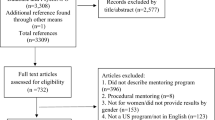Abstract
Discussion of diversity, equity, and inclusion (DEI) has moved to the forefront in medical education, and in particular, efforts toward gender equity have emphasized the need for more women faculty and physicians. Gender parity was recently achieved for medical students matriculating into US allopathic schools during the 2017–2018 academic year1. However, this documented increase in women attending medical school as students is not matched by an increase in women teaching in the undergraduate medical education (UME) curriculum. In 2020, the faculty employed by medical schools across the USA (totaling 186,311) includes 43% women; this percentage drops significantly when considering the rank of full professor, of which only 26% are women [1]. For faculty representing graduate programs in science, technology, engineering, and math (STEM), many of which teach in the pre-clerkship phase of UME, less than 25% are women [2], according to the 2019 AAMC statement of gender equity.

Similar content being viewed by others
References
AAMC Board of Directors. Applicants and Matriculants Data. Association of American Medical Colleges. https://www.aamc.org/data-reports/students-residents/interactive-data/2020-facts-applicants-and-matriculants-data. 2021. Accessed 18 Jul 2021.
Webster TL, Honeycutt KJ, Bekcer BJ, Haggar FL, Kennel VL, McBrien SB. Fix your leaky pipelines: support women in pursuit of advanced degrees. Med Sci Ed. 2021;31:795–804.
AAMC Board of Directors. AAMC statement on gender equity. Association of American Medical Colleges. 2020. https://www.aamc.org/about-us/equity-diversity-inclusion/aamc-statement-gender-equity. Accessed 18 July 2020.
Babaria P, Bernheim S, Nunez-Smith M. Gender and the pre-clinical experiences of female medical students: a taxonomy. Med Educ. 2011;45(3):249–60. https://doi.org/10.1111/j.1365-2923.2010.03856.x.
Crosby RMH, Harden J. AMEE Guide No 20: The good teacher is more than a lecturer - the twelve roles of the teacher. Med Teach. 2000;22(4):334–47. https://doi.org/10.1080/014215900409429.
Farkas AH, Allenbaugh J, Bonifacino E, Turner R, Corbelli JA. Mentorship of US medical students: a systematic review. J Gen Intern Med. 2019;34(11):2602–9. https://doi.org/10.1007/s11606-019-05256-4.
Maudsley RF. Role models and the learning environment: essential elements in effective medical education. Acad Med. 2001;76(5):432–4. https://doi.org/10.1097/00001888-200105000-00011.
Wright S, Wong A, Newill C. The impact of role models on medical students. J Gen Intern Med. 1997;12(1):53–6. https://doi.org/10.1007/s11606-006-0007-1.
Tribune H. Gender matters in medical education introduction : the gender shift in medicine. 2017:111–126. https://doi.org/10.1007/978-3-319-02487-5.
Kassab S, Abu-Hijleh M, Al-Shboul Q, Hamdy H. Gender-related differences in learning in student-led PBL tutorials. Educ Heal. 2005;18(2):272–82. https://doi.org/10.1080/13576280500148577.
Bright CM, Duefield CA, Stone VE. Perceived barriers and biases in the medical education experience by gender and race. J Natl Med Assoc. 1998;90(11):681–8.
Vu C, Farez R, Simpson P, Kaljo K. Gendered differences in teaching performance evaluations of obstetrics and gynecology residents. J Surg Educ. 2021;34(11):2602–9. https://doi.org/10.1016/j.jsurg.2021.04.011.
Riese A, Rappaport L, Alverson B, Park S, Rockney RM. Clinical performance evaluations of third-year medical students and association with student and evaluator gender. Acad Med. 2017;92(6):835–40. https://doi.org/10.1097/ACM.0000000000001565.
Morgan HK, Purkiss JA, Porter AC, et al. Student evaluation of faculty physicians: gender differences in teaching evaluations. J Women’s Heal. 2016;25(5):453–6. https://doi.org/10.1089/jwh.2015.5475.
Heath JK, Weissman GE, Clancy CB, Shou H, Farrar JT, Dine CJ. Assessment of gender-based linguistic differences in physician trainee evaluations of medical faculty using automated text mining. JAMA Netw Open. 2019;2(5):e193520. https://doi.org/10.1001/jamanetworkopen.2019.3520.
Özgümüs A, Rau HA, Trautmann ST, König-Kersting C. Gender bias in the evaluation of teaching materials. Front Psychol. 2020;11. https://doi.org/10.3389/fpsyg.2020.01074.
Fassiotto M, Hamel EO, Ku M, et al. Women in academic medicine: measuring stereotype threat among junior faculty. J Women’s Heal. 2016;25(3):292–8. https://doi.org/10.1089/jwh.2015.5380.
Azam TU, Oxentenko AS. Gender parity in medical school does not equal gender parity in medical school leadership. J Women’s Heal. 2019;28(5):563–4. https://doi.org/10.1089/jwh.2019.7762.
Pololi LH, Krupat E, Civian JT, Ash AS, Brennan RT. Why are a quarter of faculty considering leaving academic medicine? A study of their perceptions of institutional culture and intentions to leave at 26 representative U.S. medical schools. Acad Med. 2012;87(7):859–869. https://doi.org/10.1097/ACM.0b013e3182582b18.
Weavind L, Jobin MT. Women mentoring women in academic medicine: pathways to success. Int Anesthesiol Clin. 2018;56(3):110–20. https://doi.org/10.1097/AIA.0000000000000192.
Carr PL, Gunn CM, Kaplan SA, Raj A, Freund KM. Inadequate progress for women in academic medicine: findings from the national faculty study. J Women’s Heal. 2015;24(3):190–9. https://doi.org/10.1089/jwh.2014.4848.
Cropsey KL, Masho SW, Shiang R, Sikka V, Kornstein SG, Hampton CL. Why do faculty leave? Reasons for attrition of women and minority faculty from a medical school: four-year results. J Women’s Heal. 2008;17(7):1111–8. https://doi.org/10.1089/jwh.2007.0582.
Roper RL. Does gender bias still affect women in science? Microbiol Mol Biol Rev. 2019;83(3). https://doi.org/10.1128/MMBR.00018-19.
Marshall AL, Dversdal RK, Murphy M, Prill DM, Zhang T, Jain S. WOMENtorship: The #WomenInMedicine perspective. Med Teach. 2020;42(2):228–30. https://doi.org/10.1080/0142159X.2019.1671967.
Blood EA, Ullrich NJ, Hirshfeld-Becker DR, et al. Academic women faculty: are they finding the mentoring they need? J Women’s Heal. 2012;21(11):1201–8. https://doi.org/10.1089/jwh.2012.3529.
Poole EL, Spies MA. Relationship among faculty fatigue, academic rank, and scholarship and service productivity. J Adv Nurs. July 2021:jan.14990. https://doi.org/10.1111/jan.14990.
Delp L. Women’s hidden work Linda Delp. NEW Solut A J Environ Occup Heal Policy. 2011;20(4):415–9. https://doi.org/10.2190/NS.20.4.b.
Author information
Authors and Affiliations
Corresponding author
Ethics declarations
Ethics Approval
This work was designated non-human subject research by the IRB at the University of Cincinnati College of Medicine.
Competing Interests
The authors declare no competing interests.
Additional information
Publisher's Note
Springer Nature remains neutral with regard to jurisdictional claims in published maps and institutional affiliations.
Supplementary Information
Below is the link to the electronic supplementary material.
Rights and permissions
Springer Nature or its licensor (e.g. a society or other partner) holds exclusive rights to this article under a publishing agreement with the author(s) or other rightsholder(s); author self-archiving of the accepted manuscript version of this article is solely governed by the terms of such publishing agreement and applicable law.
About this article
Cite this article
Christensen, H.R., Bognar, E.S. Mentors and Role Models: the Role Female Medical Educators Serve for Female Medical Students. Med.Sci.Educ. 33, 517–522 (2023). https://doi.org/10.1007/s40670-023-01776-1
Accepted:
Published:
Issue Date:
DOI: https://doi.org/10.1007/s40670-023-01776-1




